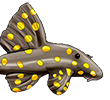www.ijisrt.com
https://www.researchgate.net/profile/Jo ... ential.pdf
Abstract:- The flooded fields of Maranhão form an immense floodplain, variable according to the rainfall regime in the region, whose characteristics are conducive to the feeding, reproduction and growth of various species, with considerable commercial interest and with morphophysiological aspects that suggest a adaptability for feedlot fish production. Thus, this study aimed to elucidate the main species of siluriformes in the flooded fields of the plains of Maranhão with zootechnical potential. Through literary review, three catfish species of the order Siluriformes, Pimelodus blochii, Hemisorubim platyrhynchos and Trachelyopterus galeatus, whose size reached 25, 50 and 18 cm, respectively, were identified. The studies approached suggest that different sizes of granules in the diets are administered according to the size of the species, also varying the percentages of proteins in the composition of the diets according to the feeding habits and the confinement periods, observing the stock densities and the feed conversion rates. As the consumption of these species of fish is very frequent in regional cuisine, the intense demand has led to practices that include overfishing and the imprisonment of fish in flooded lakes and fields, making it difficult to conclude processes of reproductive and food migration. Thus, with more studies in the literature, it will be possible to obtain more knowledge about techniques that assist in zootechnical production, which will allow the knowledge of methods of confinement and the massification of large-scale production, which will provide services to a population in need of food, in addition to the conservation and restoration of the natural stocks of these fish species.
- Keywords: Pisciculture, Siluriformes, Fish production, Zootechnics.







